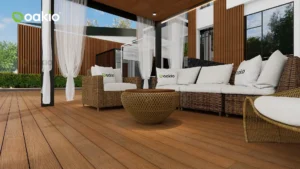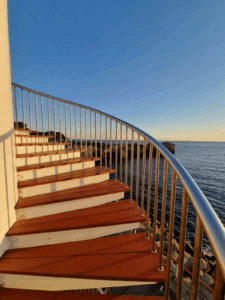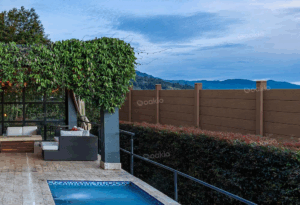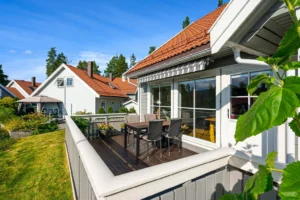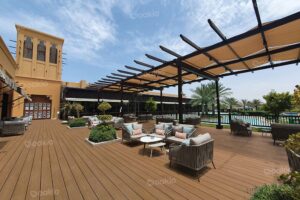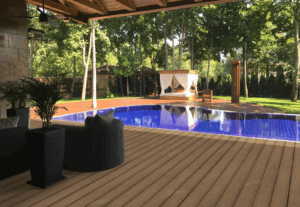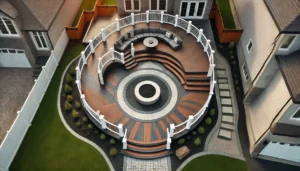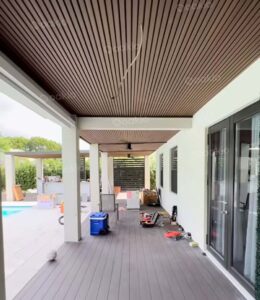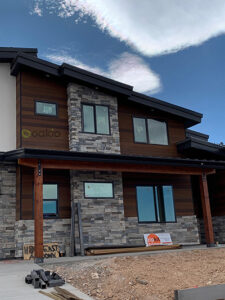All My Choices: Which Kind of Decking Wood Should I Buy?
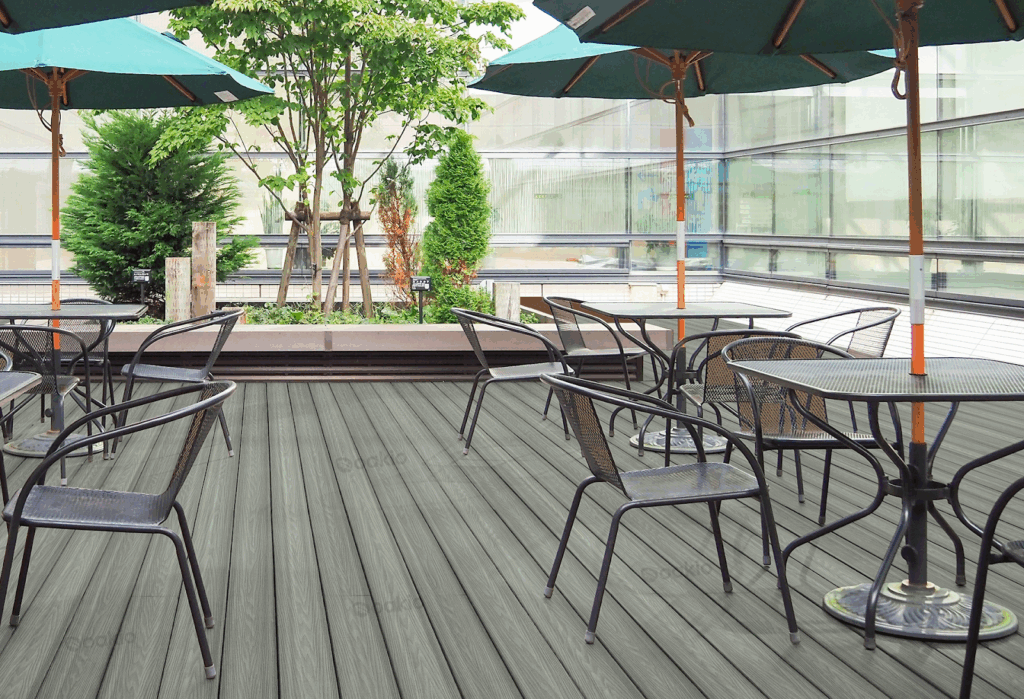
Picking the right decking wood can be the difference between having the perfect outdoor space and having dozens of hours wasted in regret. However, with so many materials on the market, it can be difficult to know what you need to look for.
If you’re looking for a material that feels natural, then either pressure-treated wood or regular wood may be ideal for you. But you’re looking at constant maintenance in staining, sealing, and cleaning, which can be very time-consuming.
Wood Plastic Composite (WPC) and PVC are two different plastic alternatives that require minimal maintenance. The difference between them is in their composition. WPC is made of a blend of wood fibers and recycled plastic, while PVC is purely plastic.
So let’s start breaking down the four most common decking wood types: pressure-treated wood, regular wood, PVC, and WPC. This way, you can learn the differences and make an informed choice.
The 4 Most Common Kinds of Decking Material in 2025
Pressure-Treated Wood Decking
Pressure-treated wood is wood that has been infused with chemical preservatives. This process involves placing the wood in a cylinder, flooding it with a preservative solution, applying pressure, and then draining the excess.
This type of wood is generally more affordable than most other wood options while still maintaining a natural appearance, and its durability means that you are less likely to incur expensive repairs in the future.
However, pressure-treated wood is still susceptible to warping, cracking, and rotting over time. To protect your deck, regular maintenance such as sanding, sealing, and staining is necessary. Without proper care, the wood may splinter and deteriorate, especially in wet conditions.
Although it has a longer lifespan than untreated wood, pressure-treated wood typically lasts between 10 and 15 years with the right maintenance. That said, environmental conditions can greatly influence its longevity.
Pressure-treated wood is an ideal choice for budget-conscious homeowners who are prepared to dedicate time and money to its upkeep.
Regular Wood Decking
Redwood, cedar, ipe, and other types of wood decking provide a rich and unmatched natural aesthetic. These woods are recognized for their premium quality, and hardwood options offer exceptional durability.
However, wood decking requires maintenance similar to that of pressure-treated wood. Regular sealing, sanding, and staining are necessary to maintain their appearance and prevent deterioration. Additionally, they are susceptible to weather damage, splitting, fading, and insect infestations.
When sourced from sustainably managed forests, wood can be one of the most environmentally friendly options available. Nevertheless, the increasing demand for wood contributes to global deforestation.
When taking all these factors into account, wood decking can have higher initial costs, and ongoing maintenance expenses can accumulate over time.
For homeowners in search of a luxurious natural wood aesthetic, nothing compares to premium wood decking. If you are prepared to invest the effort and resources in maintenance while ensuring a sustainable supplier, this decking material may be the perfect choice for you.
PVC Decking
PVC decking is made entirely of plastic, specifically unplasticized polyvinyl chloride. This high-performance material is designed to endure outdoor conditions for extended periods, exhibiting strong resistance to mold, mildew, insects, decay, and moisture.
It comes in a wide range of colors and finishes that replicate the look of real wood. But unlike traditional wood, PVC decking requires minimal maintenance. There is no need to stain, seal, or sand it. All that is needed is to occasionally clean it.
PVC decking can support significant weight, making it suitable for hot tubs and areas with heavy foot traffic. Some products offer enhanced safety and comfort features, such as cooler surface technologies and slip-resistant textures, although they can feel slicker when wet compared to composite decking.
In comparison to pressure-treated wood, PVC decking has a higher upfront cost, but it is comparable to high-end hardwoods. However, more environmentally conscious consumers have raised concerns that the manufacturing process may release harmful chemicals.
Overall, PVC decking presents an excellent option for those seeking a long-lasting, low-maintenance alternative that resembles wood and can withstand outdoor elements.
Wood Plastic Composite (WPC) Decking
Wood-plastic composites are composite materials that combine wood fibers with plastic polymers. The result is a versatile and durable decking material that mimics the appearance of natural wood while offering enhanced performance and longevity and is often capped for enhanced protection.
Thanks to its composition, WPC has several unique advantages.
The key advantage is its low maintenance. WPC decking only needs occasional cleaning with soap and water to keep it looking its best. There is no need for sealing or staining. It is capable of keeping its appearance the same year after year. While it may be somewhat more prone to mold than PVC, it still offers high resistance when properly maintained through regular cleaning.
Durability is another strong suit. WPC decking is highly resistant to rot, insect damage, splintering, and fading. This means that they can last between 25 and 30 years without needing repairs. Leading composite brands, like Oakio, offer warranties of up to 25 years on capped products.
Many manufacturers like Oakio use recycled materials for WPC decking boards, making them a sustainable choice for the environmentally conscious. This process results in fewer harmful emissions than PVC.
WPC decking is available in a variety of colors, finishes, and textures, allowing homeowners to customize the decks to suit their preferences. It can even mimic the natural wood appearance with a rougher texture to give excellent slip resistance.
However, composite wood typically has a higher initial cost compared to regular wood and, in some instances, PVC materials. Its increased density makes it more challenging to cut than PVC, which can complicate DIY projects.
For homeowners looking for a decking option that is low-maintenance, sustainable, and long-lasting while closely mimicking the appearance of natural wood, composite wood decking material is an excellent choice.
H2: Comparison Summary Table
When selecting the ideal material for your project, it’s vital that you consider several factors, including its durability, maintenance requirements, initial cost, warranty options, aesthetic appeal, and environmental impact.
Here is a summary comparing common decking materials. Consulting this table can help you make a well-informed choice that aligns with your preferences and requirements.
| Material | Maintenance | Durability | Appearance | Cost (Upfront) | Eco-Friendliness | Maintenance Frequency | Longevity Warranty |
| Pressure-Treated Wood | High | Moderate | Natural wood look | Low | Moderate | Annual sealing, staining, and inspections | 10-15 years |
| Regular Wood (Cedar, Ipe) | High | High | Rich natural wood | High | Low to Moderate | Seasonal cleaning and refinishing | 15-30 years |
| PVC Decking | Minimal | Very High | Wood-like but synthetic | High | Moderate | Occasional cleaning | Up to 50 years |
| WPC Decking | Low | High | Natural wood look | Moderate to High | High | Occasional cleaning | Up to 25 years |
Pressure-treated wood decking provides a moderate level of durability while maintaining a natural wood appearance and offering a low upfront cost. Its durability contributes to a moderate level of eco-friendliness. However, it requires significant and frequent maintenance. You can expect it to last about 10 to 15 years before needing replacements.
Regular wood decking delivers outstanding durability but comes with a high upfront cost. While its rich natural wood appearance is unmatched, it also demands substantial and frequent maintenance. Its level of environmental friendliness can range from moderate to poor, depending on where it comes from. You can anticipate it to last about 15 to 30 years before requiring complete replacement.
PVC decking offers excellent durability, though it has a high upfront cost and a synthetic wood-like appearance. Nonetheless, it compensates for this by requiring minimal maintenance. Coupled with its durability, it can be a moderately eco-friendly option. It can last for roughly 50 years before you need to think about replacing it.
Wood plastic composite decking provides outstanding durability at a moderate to high upfront cost. It also requires little maintenance. Typically made from recycled wood fibers and plastics, these materials are highly eco-friendly. This decking is designed to last for approximately 25 years before it may require renovations.
How to Choose the Best Decking Wood for You
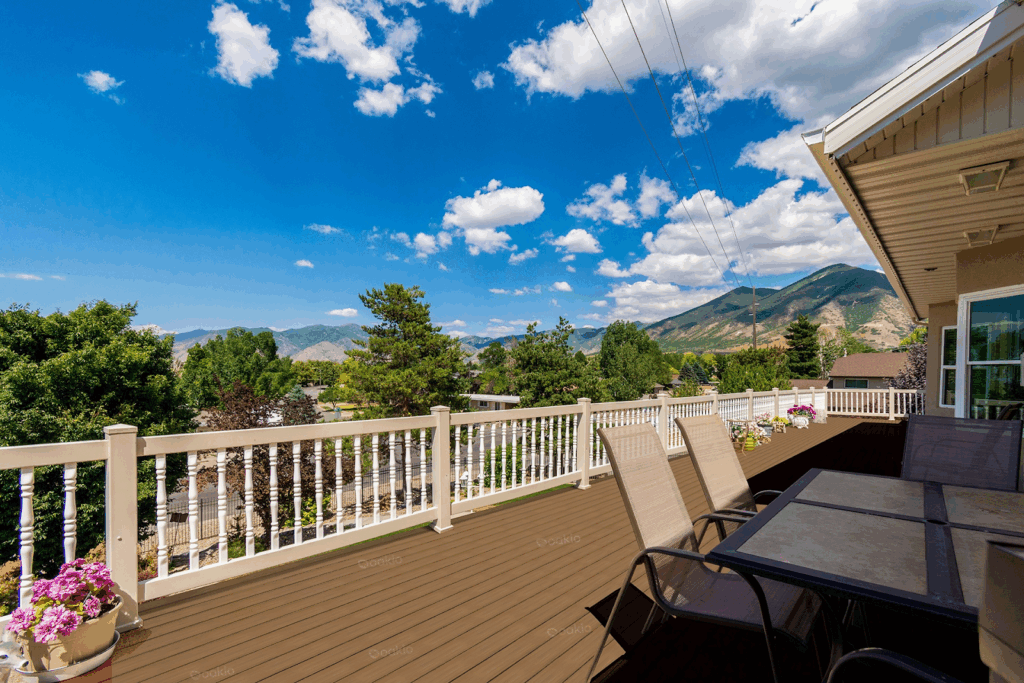
The recommended wood for decks depends on your budget, how complex you want the installation to be, the aesthetic you want, how often you want to maintain it, and the location’s needs.
Starting with cost, WPC and PVC decking cost more than pressure-treated wood, but they last longer and require less maintenance, saving money over time. Another important consideration is installation difficulty. Hidden fasteners and standard sizing make WPC boards easier to install, saving time and money.
Consider how much you want to maintain the deck. WPC and PVC only need occasional washing, while pressure-treated and natural wood must be sealed, stained, and cleaned regularly.
The location of your deck matters too. PVC and WPC are ideal deck materials for humid or rainy areas. Both pressure-treated and natural wood, on the other hand, are better for dry climates but need proper care. Evaluate the level of safety and slip resistance required for your flooring, as WPC and PVC can provide protection against slips, mold, and wear from heavy foot traffic.
Overall, PVC and wood plastic composite decking are ideal long-term options for homeowners who want an easy-to-maintain, eco-friendly, and attractive solution. Their strength and flexibility make them ideal for modern outdoor spaces.
Conclusion
The right decking wood depends on your specific decking requirements and priorities. Evaluate your budget, lifestyle, and the aesthetic you envision for your ideal decking to help guide the most suitable decking material for you.
If you appreciate the authentic beauty of wood and are prepared to dedicate time and resources to upkeep, staining, and board replacement, then pressure-treated wood or classic wood decking could be the ideal option for your outdoor space.
For those in search of a resilient, low-maintenance solution that is resistant to weather and pests, PVC or WPC stands out as an excellent option, especially since manufacturers provide a diverse range of colors and finishes that allow you to seamlessly mix and match elements that can integrate well with your home.
Are you still weighing your options? Why not request Oakio for a free sample while you have the chance? This way, you can see and feel the color and texture for yourself, which will help you choose the decking that fits your needs and tastes to elevate your outdoor space.
Trending Reading
What Are the Differences Between the WPC Board and PVC Board?
[2025 Update] How Long Does WPC Decking Last?

